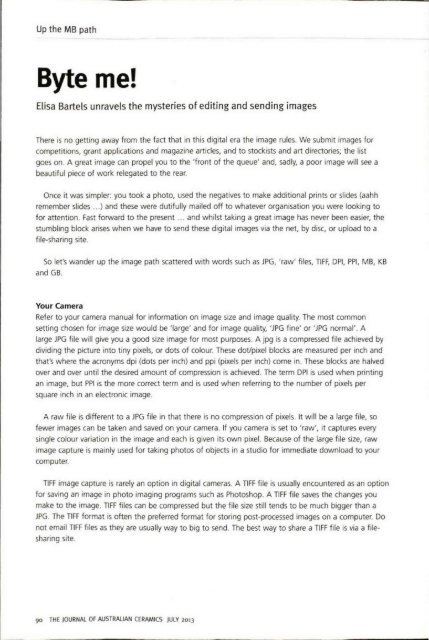The Journal of Australian Ceramics Vol 52 No 2 July 2013
You also want an ePaper? Increase the reach of your titles
YUMPU automatically turns print PDFs into web optimized ePapers that Google loves.
Up the MB path<br />
Byte me!<br />
Elisa Bartels unravels the mysteries <strong>of</strong> editing and sending images<br />
<strong>The</strong>re is no getting away from the fact that in this digital era the image rules. We submit images for<br />
competitions, grant applications and magazine articles, and to stockists and art directories; the list<br />
goes on. A great image can propel you to the 'front <strong>of</strong> the queue' and, sadly, a poor image will see a<br />
beautiful piece <strong>of</strong> work relegated to the rear.<br />
Once it was simpler: you took a photo, used the negatives to make additional prints or slides (aahh<br />
remember slides ...) and these were dutifully mailed <strong>of</strong>f to whatever organisation you were looking to<br />
for attention. Fast forward to the present ... and whilst taking a great image has never been easier, the<br />
stumbling block arises when we have to send these digital images via the net, by disc, or upload to a<br />
file-sharing site.<br />
So let's wander up the image path scattered with words such as JPG, 'raw' files, TIFF, DPI, PPI, MB, KB<br />
and GB.<br />
Your Camera<br />
Refer to your camera manual for information on image size and image quality. <strong>The</strong> most common<br />
setting chosen for image size would be 'large' and for image quality, 'JPG fine' or 'JPG normal'. A<br />
large JPG file will give you a good size image for most purposes. A jpg is a compressed file achieved by<br />
dividing the picture into tiny pixels, or dots <strong>of</strong> colour. <strong>The</strong>se dot/pixel blocks are measured per inch and<br />
that's where the acronyms dpi (dots per inch) and ppi (pixels per inch) come in. <strong>The</strong>se blocks are halved<br />
over and over until the desired amount <strong>of</strong> compression is achieved. <strong>The</strong> term DPI is used when printing<br />
an image, but PPI is the more correct term and is used when referring to the number <strong>of</strong> pixels per<br />
square inch in an electronic image.<br />
A raw file is different to a JPG file in that there is no compression <strong>of</strong> pixels. It will be a large file, so<br />
fewer images can be taken and saved on your camera. If you camera is set to 'raw', it captures every<br />
single colour variation in the image and each is given its own pixel. Because <strong>of</strong> the large file size, raw<br />
image capture is mainly used for taking photos <strong>of</strong> objects in a studio for immediate download to your<br />
computer.<br />
TIFF image capture is rarely an option in digital cameras. A TIFF file is usually encountered as an option<br />
for saving an image in photo imaging programs such as Photoshop. A TIFF file saves the changes you<br />
make to the image. TIFF files can be compressed but the file size still tends to be much bigger than a<br />
JPG. <strong>The</strong> TIFF format is <strong>of</strong>ten the preferred format for storing post-processed images on a computer. Do<br />
not email TIFF files as they are usually way to big to send. <strong>The</strong> best way to share a TIFF file is via a filesharing<br />
site.<br />
90 THE JOURNAL OF AUSTRALIAN CERAMICS JULY <strong>2013</strong>

















